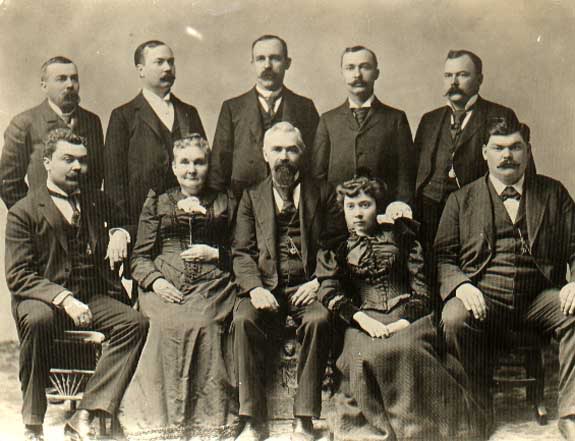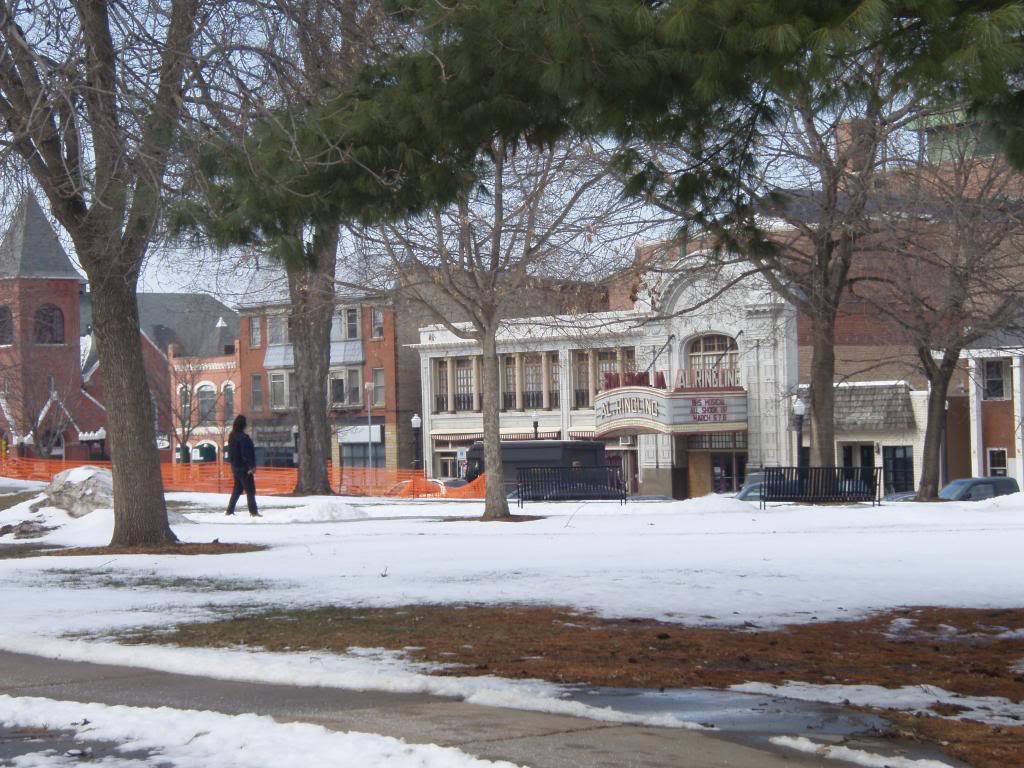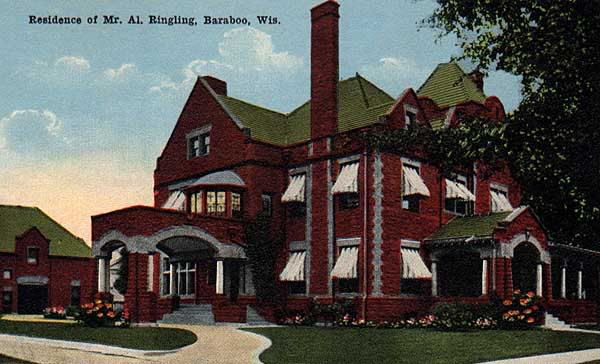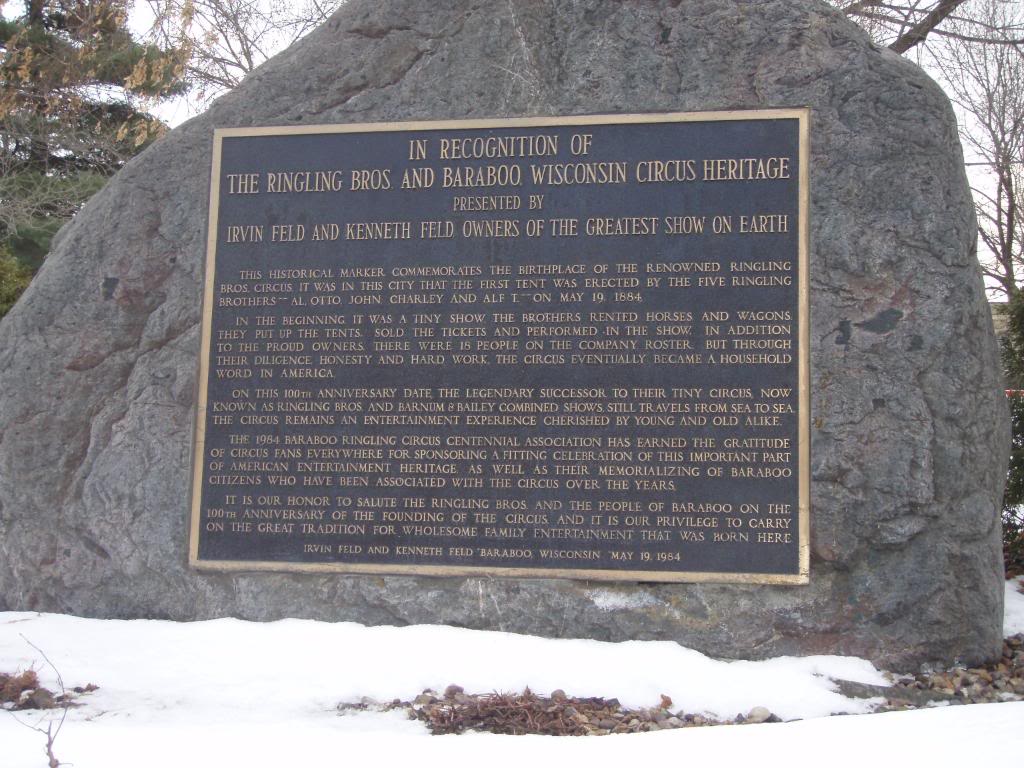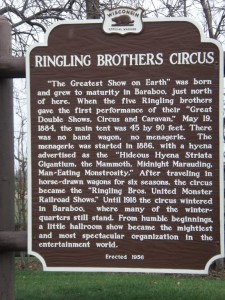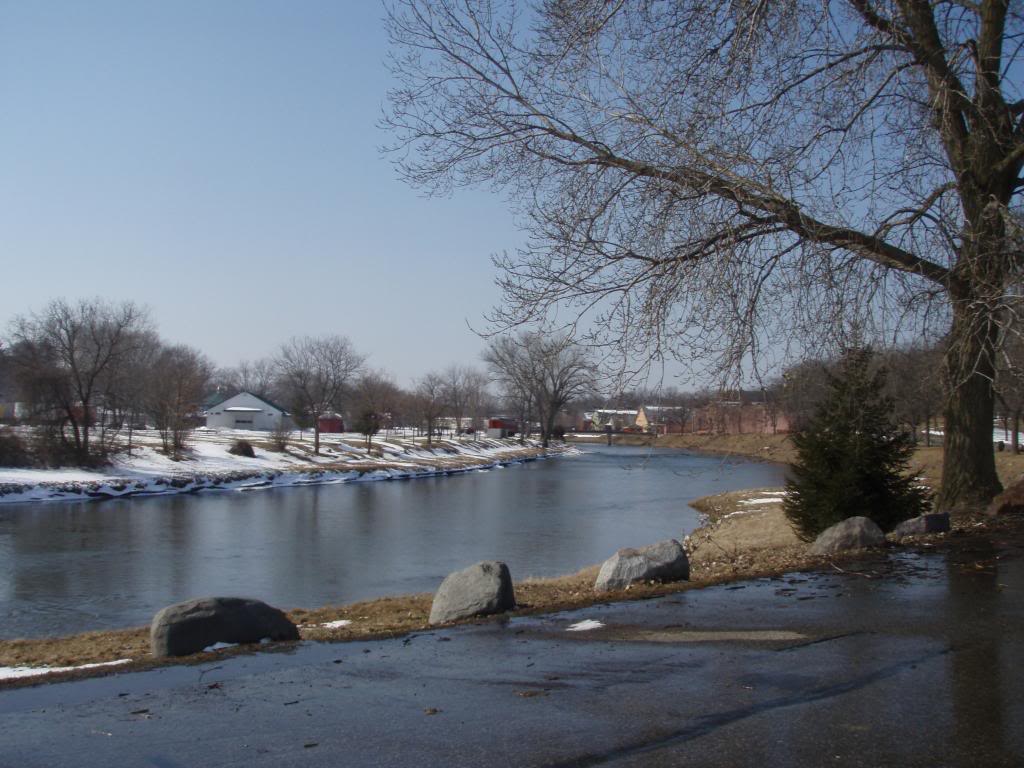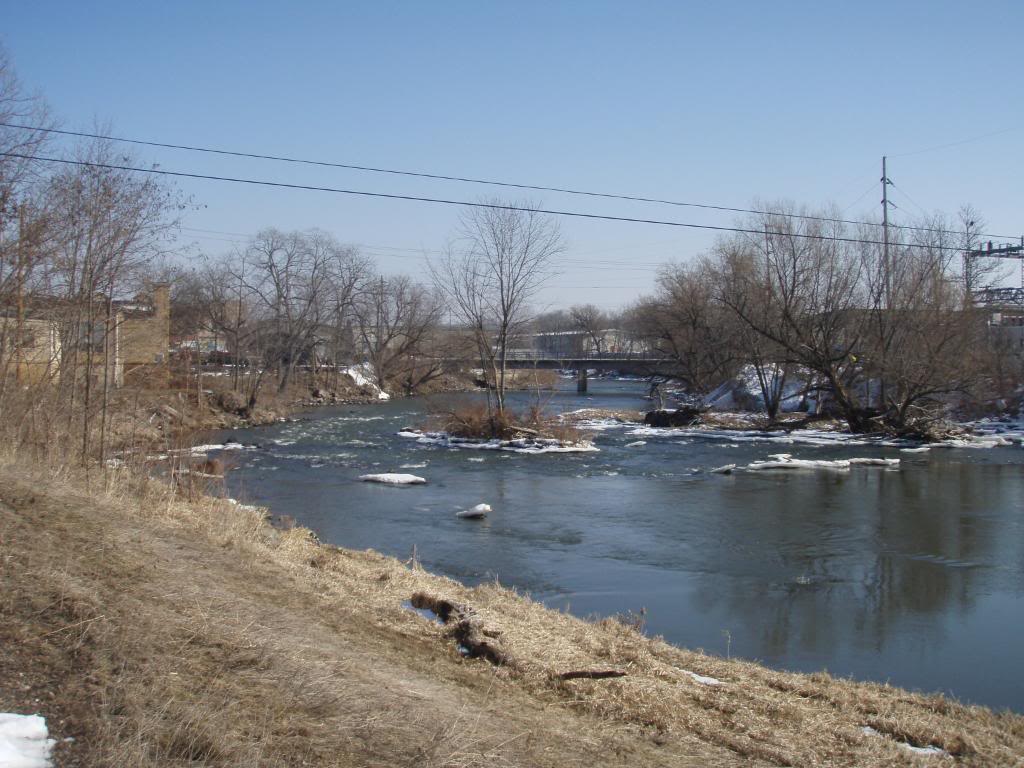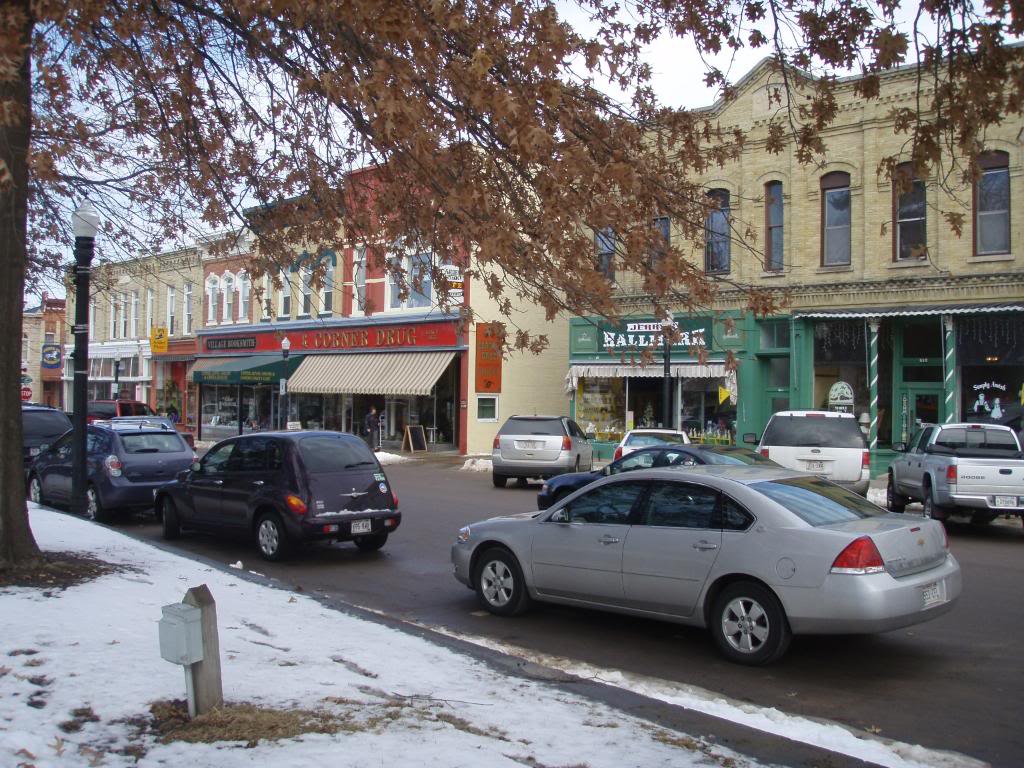By Mary Fairchild
Ringling’s: ABT. 1895, left to right–Al, Alf T., Gus, Charles, Otto. Seated–John, Salome and August (parents), Ida (Mrs. North), Henry.
Did you know that if you drive into Baraboo, Wisconsin, on Rt. 33 that it turns into “Ringling Boulevard?” The Ringling riverfront property is actually on Water Street, however. The city of Baraboo is developing the Ringling riverfront into a thriving part of the city.
Al Ringling Theater in downtown Baraboo.
A religious man, August Ringling never allowed their shows to be held on Sunday. The Ringlings became known as the “Sunday School Show” as they chose not to follow the crowds of their day and were strict about no profanity or drunkenness among any of the crew. The Al Ringling Theater would not allow any of the burlesque influences that other theaters where beginning to include at that time either. It is said that their claim to fame rested on their “genuine appreciation for their guests.” Their circus always remained wholesome entertainment for the whole family. Modeled after French theaters like the Palace of Versailles, the theater was considered a gift to Baraboo. On June 24th, thousands gathered in front of Al Ringling’s residence to show their gratitude and the day was called “Al Ringling Appreciation Day.” The theater is still open today.
As you enter the downtown area, a red stone mansion appears on the west side of Broadway Street which was built for Al and Lou Ringling. The architects would later become quite famous. Once the social center in Baraboo in the early 1900s, now it is owned by the B.P.O.E (Elks Club).
After the family moved back to Baraboo from McGregor, Iowa, the five brothers made their decision to start the circus. Their first performance was just one block down Broadway on May 19th, 1884. The seven sons had been born of recent immigrants who escaped poverty through hard work. In his book “Ringlingville USA,” Jerry Apps explains that they chose a path in which they had no experience or capital. It was also one of the riskiest businesses in the world. Apps concludes through his detailed research into the business reports and transactions between the brothers that the secret of their achievements was teamwork, facilitated by their personal bonds. It was not the paperwork, but the mutual respect and trust between the brothers that empowered them to rise above their competitors.
After joining up with the Barnum & Bailey Show in 1919, winter quarters where soon set up in Bridgeport, CT, and Sarasota, FL. In choosing Barnum as one of the 100 most important people of the millennium, LIFE magazine dubbed him “the patron saint of promoters.” A year later, he exhibited “The Feejee Mermaid” purchased near Calcutta by a Boston seaman. Barnum and the seaman, Moses Kimball, entered into a written agreement to exploit the so-called mermaid on June 18, 1842. Kimball would remain the creature’s sole owner and Barnum would lease it for $12.50 a week. In Barnum’s exhibit, the mermaid was allegedly caught in 1842 by a “Dr. J. Griffin.” Griffin was actually Levi Lyman, one of Barnum’s close associates. This story is told in the Ripley’s Believe It Or Not Museum in downtown Wisconsin Dells.
After the Ringling brothers eventually all passed away the show was taken over by a corporation. Currently Mr. Irvin Feld and his son Kenneth own the show. Many of the Ringling family are buried in the Walnut Hill Cemetery on East Street on the northern edge of town.
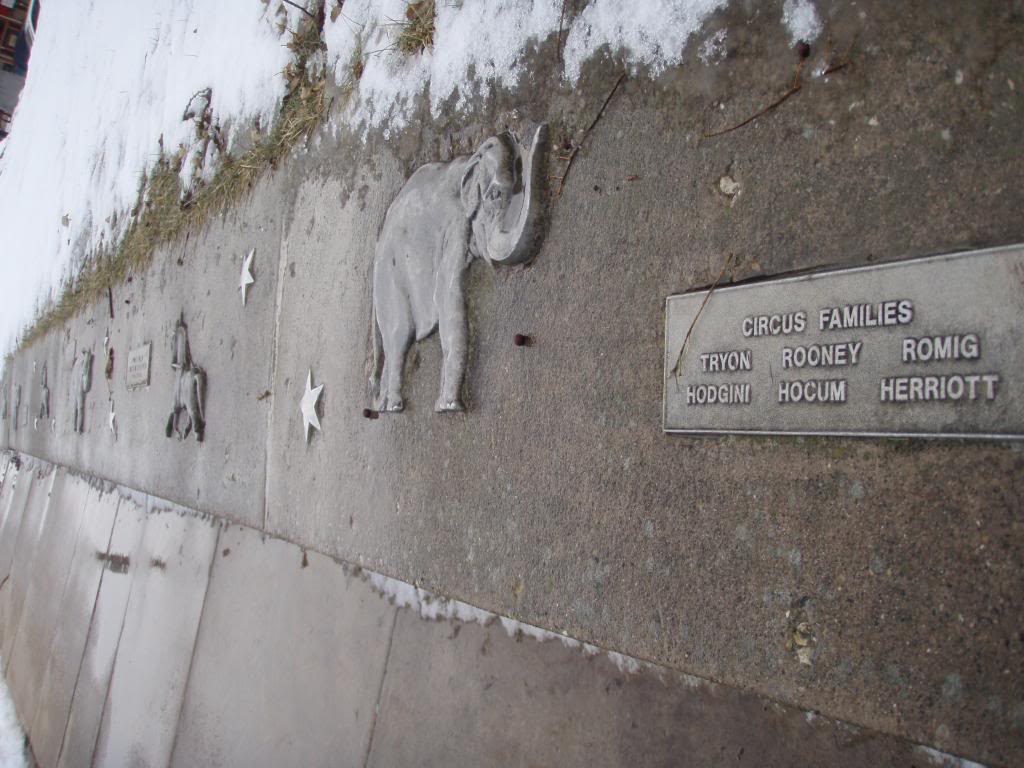 A low stone wall borders the downtown courthouse lawn on Fourth Avenue and Oak. If you look closely, you will find that it has a series of plaques that chronicle the many circus families of Baraboo on it.
A low stone wall borders the downtown courthouse lawn on Fourth Avenue and Oak. If you look closely, you will find that it has a series of plaques that chronicle the many circus families of Baraboo on it.
Just above the wall is a large stone marker detailing the area’s circus history.(click picture to read)
One afternoon on my way back from the Dells to our family campsite at Devils Lake State Park, I attempted to take a short cut to avoid the busy downtown. After an obvious wrong turn down Lynn Street I found myself driving by elephants. Ever since that day I had planned to investigate the area’s circus heritage and answer the question that kept popping up, “Why would a circus choose Baraboo, Wisconsin for winter camping grounds?”
On June 28, 2009- Sunday, July 05 from 9am -6pm the Circus World’s collection of authentic circus parade wagons will be displayed throughout the their museum grounds called “Wagon Roll-Out Days.” During this time the wagons are made ready for their trip to Milwaukee for the Circus Parade which will be held on July 12.
A prelude to the parade begins at 1:30 pm at Milwaukee’s lakefront. The parade then meanders along the city’s major downtown before ending on Michigan Street near the parade’s point of origin. It promises to be a once-in-a-lifetime event and the largest and most extravagant historical re-creation in America. The parade had been on hiatus since 2005. It was first held in Milwaukee in 1963, and in various cities between 1985 and 2005, primarily Milwaukee (1985-2003) and Baraboo, Wisconsin (2004-2005).
If you are traveling north on I90/39 the tourist stop at mile marker 115 displays a historical marker that describes the great circus heritage in Wisconsin. (click picture to read) I was surprised to learn that the Ringlings actually started a little later in the game and that Delevan had been the first circus area in the state. According the Jerry Apps in his book, “Ringlingville USA.” Several circuses would settle in Wisconsin where they could practice in the Midwest before going to the east coast among their competitors. Delavan, Wisconsin became the major circus center housing some 26 circuses for winter quarters between the years 1847 and 1894.
I didn’t always attempt to stop to read historical markers, but I began finding myself passing so many in the area that I just got curious after awhile. Driving south on Rt. 12 just past the Baraboo River bridge you will find a historical marker on the east side of the road. (click to read)
The Nature Conservancy has designated the Baraboo Range as one of the last great places on earth. Nowhere is the evidence of the glaciers better preserved than across Wisconsin. Reknown for its ice age geology, the Baraboo Range, which is carved by the Baraboo River, is marked with two historical markers.
Perhaps it’s just a coincidence but, in the book “Images of America–Baraboo,” by the Sauk County Historical Society, we find that the south side of Baraboo which is also the Ringling riverfront area, a mammoth skeleton was excavated in 1844 when the first dam was built at Oak Street. The mammoth and the American mastodon, the elephants’ last living relatives, are believed to have become extinct during the Ice Ages. Although the mastodon skeleton was not salvageable and turned to dust as it was surfaced, it almost seems fitting to learn that the Ringling Bros and Barnum & Bailey Circus would not only feature elephants but become stewards of the endangered Asian elephant.
Also in the show as well as on the endangered species list is the tiger. Did you know that tigers can live in almost any climate? I found that out on the Ringling website. They only require shade, water and food. That made sense when I learned that neighboring Rock Springs had a “big cat rescue.” Big cats showcased at Ringling Bros. and Barnum & Bailey have a relationship with their trainers based on mutual trust and respect. Because the big cats are incredibly strong and fierce, however, they always perform behind a barrier.
The “big cat rescue in neighboring Rock Springs and Educational Center opened to visitors for the first time in late April of 2008. Founder Jeff Kozlowski and a crew of volunteers led visitors through the fenced-in sanctuary on the south edge of the town. The organization provides refuge for abused and abandoned lions, tigers and leopards.
Ringling Bros. employs a full-time veterinary staff to provide ongoing medical care for all of their animals. Each animal in their circus family receives regular, thorough medical examinations and all needed vaccinations. Each touring unit has its own veterinary technician who travels with the show and provides daily medical care to the animals, while two full-time veterinarians travel between the units. In addition, they work with a network of 90 local veterinarians, and one is on call 24 hours a day in each city where the show performs.
Baraboo is committed to seeing the Ringling riverfront redevelop into a thriving part of Baraboo. According to the Ringling Riverfront Development Plan, the city has a thriving central business district two blocks directly to the north of the Ringling riverfront.
The land located on both sides of the river between Broadway and Walnut/Ash Street is envisioned to contain a mix of entertainment, retail, and residential uses that orient toward the river and the Circus World Museum. Uses would include restaurants, a brew pub, public spaces along the riverwalk, and four season activities. (picture: looking east toward Walnut/Ash Street from Broadway.)
A strong pedestrian connection along Oak Street is planned to connect the downtown to the riverfront.
RELATED
- Little Village Cafe
- Midwest Weekends
- Old Copper Culture: A Visit With Pete Stark
- Sea Change and Sea Kayaking (Door County artifacts)
- Kayaking Georgia’s Coast: Tidal Flat Ecosystems, Ancient History, and Stewardship (Shell Middens)
- Local Native Americans Buried in Blue Wing Cemetery by Ross M. Curry
- Paddling Lake Okoboji (Inkapaduta, Abbie Gardner)
- Wisconsin’s Indian Mounds

